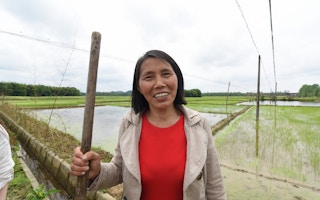As in so many developing countries, agriculture in many parts of the People’s Republic of China (PRC) has long suffered perennial challenges, including low productivity resulting in poverty, vulnerability to climatic conditions, and inefficient sales channels.
Although farmers’ incomes have been rising, the average is still under $5 a day, less than half the average urban income, and is dragging down the country’s rural economy as a whole. The agriculture sector absorbed 27.7 per cent of the total labor force in 2016, but its contribution to GDP was only 8.6 per cent.
Boosting agriculture productivity and the rate of return on farming are key to making the PRC’s development more inclusive.
The internet is a powerful tool to enhance productivity on the farm. It can help farmers sell their produce quickly, and allow them to shop around for inputs and materials. But through the use of Big Data, it can also enable them to apply such inputs more efficiently and effectively with better understanding of weather and climatic conditions as well as market demand.
Productive farms not only contribute more to economic growth. They raise the income of farmers, and thus foster truly inclusive development. This however requires farmers to be better organized, and coordinated, possibly through agriculture cooperatives or through horizontal and vertical networks in the agriculture value chain.
“
Technologies such as drip irrigation, or precision farming, will extract maximum efficiency from the use of agriculture inputs.
In the digital age, the best way to achieve higher productivity in farming is by using information and communication technology (ICT) to support the agricultural value chain and related service systems. Agriculture products can be distributed more effectively in areas where demand is high. Big Data can also help predict possible movement of demand.
Internet Plus Agriculture
The Internet of Things (IoT) can also be useful to control water, fertiliser or to manage the temperature of greenhouses so that farmers can adjust the timing of harvest to suit the market situation.
The network-connected sensors can monitor soil moisture and air temperature. That information is then fed into data analysis centers to provide specialised, real-time production and management services to farmer cooperatives, and product safety information to consumers.
Technologies such as drip irrigation, or precision farming, will extract maximum efficiency from the use of agriculture inputs.
This is the theory behind so-called “Internet Plus Agriculture.” The entire agricultural value chain from production to marketing—or from producers to final consumers— can be connected through online networks and then integrated.
In this way, both producers and consumers gain enhanced market access through a two-way automated information exchange system supported by Big Data. The system provides transparency in the food production and distribution process, from farm to table.
Internet Plus Agriculture provides consumers with product information—such as the location and quality of agricultural produce—and producers with market information and production support services.
IoT-supported farming
This IoT-enabled platform yields many benefits. Farmers can increase production, lower their input costs, cut their carbon footprint, and reduce marketing risks. They can gain access to premium markets that demand agricultural products that can be traced all the way down the value chain to their point of origin.
Since 2015, the PRC government has been implementing Internet Plus Agriculture policies to integrate agriculture value chains into secondary and tertiary industries. The Ministry of Agriculture has established demonstration zones in eight provinces to promote IoT-supported agriculture. Stronger linkages are also being developed from production to agro-processing including packaging, logistics, marketing and consumer support.
Several ongoing pilot projects aim to transform the rural economy through ICT. And it’s not just farms going online – other projects are funding rural logistics, setting up e-commerce service stations, developing primary processing facilities and quality control systems, and helping brand establishment.
Hundreds of new technologies, products and application models have been introduced, and many more are on the way.
Applying ICT is already proving quite effective in integrating, transforming, and upgrading agriculture value chains. It helps to dramatically reduce inefficiencies at all stages of the complex agriculture value chain, and to address negative externalities such as pollution and food safety problems.
We urgently need to get many more farms online. It will boost farm productivity, and help make the PRC’s future growth more inclusive.
Ayumi Konishi is the director general, East Asia Regional Department, at Asian Development Bank.
This story was published with permission from Asian Development Bank.











